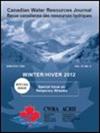加拿大阿尔伯塔省中部小湖泊磷浓度的自然控制
IF 1.7
4区 环境科学与生态学
Q3 WATER RESOURCES
引用次数: 1
摘要
小湖泊可以作为了解区域水文地质条件和元素循环的环境传感器。由于它们的体积小,它们对养分流失、地下水交换和气候的变化反应迅速。在阿尔伯塔冰川后的景观中,卡维尔坑状三角洲拥有各种各样的小湖泊,尽管它们靠得很近,但它们的化学成分和营养特征却截然不同。在这里,我们重点研究了9个表面积小于10公顷,最大深度在5到18米之间的湖泊。我们假设它们营养状态的差异是由地下水输入控制的钙浓度变化引起的。由于混合深度较小(1.6 ~ 2.4 m),所有湖泊都倾向于永久分层。较深的湖泊是低营养湖泊,沉积物中Ca浓度高,磷(Ca-bound P)含量高(HCl可提取部分)。在0.5 m深度处,钙结合磷与水钙浓度之间存在相关性,表明可以根据地表水化学来估计磷的稳定性。钙被证明集中在基岩上方的地下水中,这表明地下水的输入控制了湖泊中的钙浓度。我们得出结论,水文地质条件和钙输入是这些湖泊磷有效性的自然调节因子,进而影响水质。本文章由计算机程序翻译,如有差异,请以英文原文为准。
Natural controls on phosphorus concentrations in small Lakes in Central Alberta, Canada
abstract Small lakes can act as environmental sensors for understanding regional hydrogeological conditions and elemental cycles. Because of their small size, they react quickly to changes in nutrient runoff, groundwater exchange and climate. In the post-glacial landscape of Alberta, the Carvel Pitted Delta harbours a variety of small lakes, which, despite being close together, can have markedly different chemistries and nutrient characteristics. Here, we focused on nine lakes with surface areas <10 ha and maximal depths ranging from 5 to 18 m. We hypothesised that differences in their trophic states are caused by variations in Ca concentrations, controlled by groundwater inputs. All lakes tended toward permanent stratification due to small mixing depths (1.6–2.4 m). The deeper lakes were oligotrophic with high concentrations of Ca and a high fraction of phosphorus (Ca-bound P) in the sediments (HCl extractable fraction). A correlation was found between Ca-bound P and aqueous Ca concentrations at 0.5 m depth, suggesting that P stability could be estimated based on surface water chemistry. Calcium was shown to be concentrated in groundwater located above the bedrock, suggesting that groundwater inputs controlled Ca concentrations in the lakes. We conclude that the hydrogeological conditions and Ca inputs act as natural regulators for P availability and, by extension, water quality in these lakes.
求助全文
通过发布文献求助,成功后即可免费获取论文全文。
去求助
来源期刊

Canadian Water Resources Journal
WATER RESOURCES-
CiteScore
2.90
自引率
5.90%
发文量
17
审稿时长
>12 weeks
期刊介绍:
The Canadian Water Resources Journal accepts manuscripts in English or French and publishes abstracts in both official languages. Preference is given to manuscripts focusing on science and policy aspects of Canadian water management. Specifically, manuscripts should stimulate public awareness and understanding of Canada''s water resources, encourage recognition of the high priority of water as a resource, and provide new or increased knowledge on some aspect of Canada''s water.
The Canadian Water Resources Journal was first published in the fall of 1976 and it has grown in stature to be recognized as a quality and important publication in the water resources field.
 求助内容:
求助内容: 应助结果提醒方式:
应助结果提醒方式:


